(Strand)om Stories: The Mighty Thor by Walter Simonson Omnibus Review
This massive volume proves that Walt Simonson's run on Thor is definitive, distinct, dense, and daring
—by Nathan on April 18, 2021—
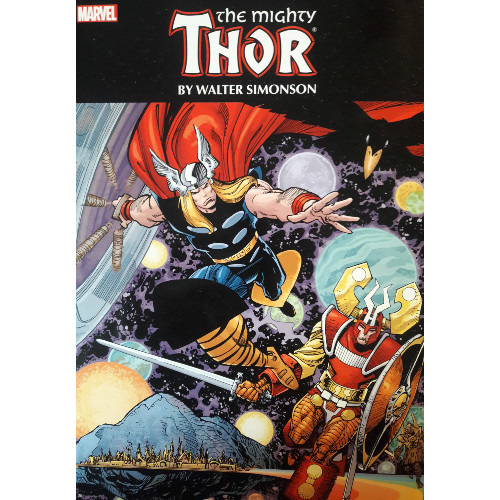
A while ago, in the midst of the “Alien Costume Saga,” I referenced a Thor story in an Al Milgrom-penned issue of Peter Parker, the Spectacular Spider-Man. I discarded the Norse elements as mere window dressing against which the ill-considered Flash Thompson/Betty Leeds romance was plastered. Little did I know at the time that, months later, I’d be plumbing the depths of that particular Thor story, and many others, as deeply as souls pour into the abyss of Hel.
Yes, you read that right. “Hel” with a single “l.” Not the Christian version of the condemned afterlife but the Norse depiction. We’ll be visiting there soon.
When I think of various Marvel characters and the creators who influenced them, particular names spring to mind. I often associate the X-Men with Chris Claremont, Daredevil with Frank Miller, or Black Panther with Christopher Priest. For some characters, multiple creators pop up. Stan Lee, Brian Michael Bendis, Gerry Conway, J. Michael Straczynski, and Tom DeFalco are all notable Spider-Man writers who have, in one way or another, left an indelible mark on the hero. These creators are often praised for their “runs,” or their particular time on a comic. Some characters are lucky enough to have several famed writers take the helm and craft their adventures.
But for Thor, that mighty Norse God of Thunder, I don’t hear of too many creators outside of Walt Simonson. I couldn’t name too many other writers who delivered epic adventure upon epic adventure. Does Stan Lee fit the bill? Roy Thomas? Straczynski? Jason Aaron? I don’t know. Yet, I’ve been aware of Simonson’s influence for years, and I know his adventures are usually the standard by which all other Thor writers are held against. So, almost on a whim, I decided to check him out. Fortunately, Simonson’s run has been lovingly preserved in omnibus format, a single tome comprising nearly 1,200 pages of mythic tales across 48 issues and two series. Dropping this thing on your foot would be like getting battered by Mjolnir. This thing is absolutely massive, and it took me quite a while to work my way through it. But I recently closed the back cover, and I can finally report on which parts of Simonson’s sprawling epic are forged in enchanted Uru metal...and which parts dissipate like a finely crafted illusion from the fingertips of a certain God of Mischief.
The Mighty Thor by Walter Simonson Omnibus
Writer: Walt Simonson
Pencilers: Walt Simonson and Sal Buscema
Issues Collected: The Mighty Thor #337-355, 357-369, 371-382; Balder the Brave #1-4
Volume Publication Date: October 2017
Issue Publication Dates: August 1983-May 1985, July 1985-July 1986, September 1986-August 1987
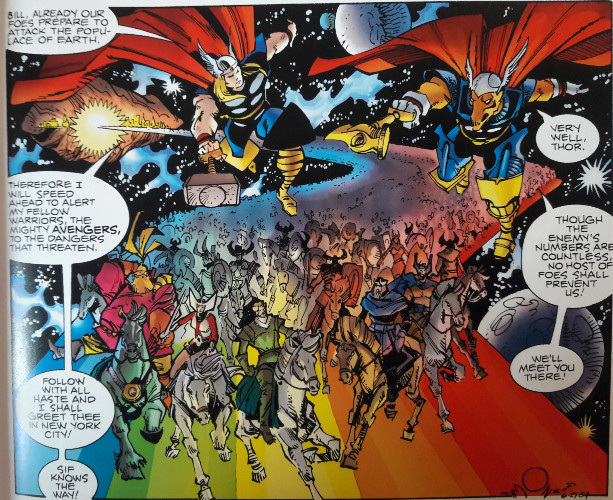
I noticed the heft first.
When I first lifted this treasured tome from its box, the weight was the first thing that came to mind. This sucker is huge, one of Marvel’s largest omnibuses to date. Reviewers online had complained slightly that, because of its Volstagg-like girth, the book can be difficult to read, particularly if you wish to have it opened in front of you on a table. I found this complaint to be moderately true from my own epxerience; though the book is easier to handle while you read it’s middle sections, strain is definitely put on the spine the deeper you get into the text, particularly on the edges where the covers meet the spine if you lay the book flat. I found it better to hold the front cover as the pages accumulated, and though it lessened the stress on the book itself, it made for some awkward reading angles. It’s certainly harder to wield than some other omnibuses, like the ones that range between the 800-1,000 page range.
The included photo shows the Thor omnibus (on the right) next to a Daredevil omnibus of about 1,000 pages long. Not sure about you, but I find the difference of 200 pages noticeable when comparing sizes.
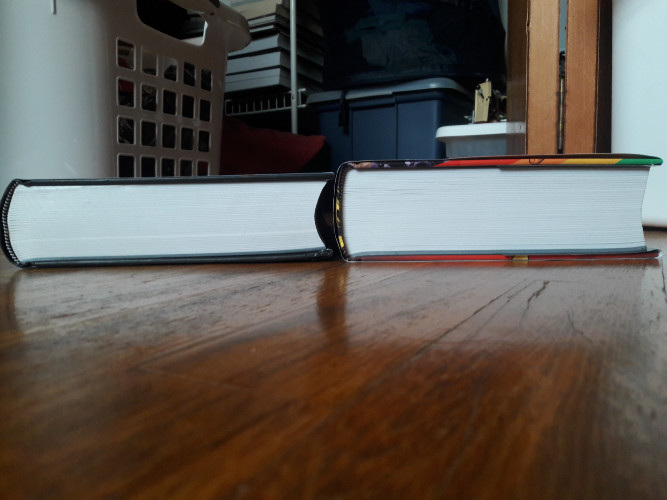
I noticed the illustrations second.
Reviewers have also commented heavily on the omnibus’ art style--though the illustrative genius of Walt Simonson (and, to a slightly lesser extent, partner-in-crime Sal Buscema) remains perfectly intact, the volume’s coloring has been redone digitally, altering it from the original issues. Prior to purchasing the volume, I researched views on this new coloring and came away with a plethora of opinions. Some people enjoyed it, some tolerated it, others felt like it didn’t really matter overall. Reading the first few issues, I found my mind occasionally drifting, wondering how this volume would have looked if the original coloring had been kept. The farther I got into the volume, fortunately, this potential problem faded into the back of my mind; I became so enticed by the stories provided, I barely paid attention to the color. Perhaps one minor complaint on my end is that the coloring gives the volume a decidedly 90s feel to it, rather than 80s. I recently read a few Spider-Man omnibus with “Clone Saga” stories from the 90s, and the coloring looks similar in the Spidey volumes and the Thor omnibus. Other than occasionally appearing a little awkward, the update didn’t bug me much at all; truth be told, the characters and backgrounds often feel more extravagant, particularly as Simonson pervades his mythical worlds with bombastic imagery.
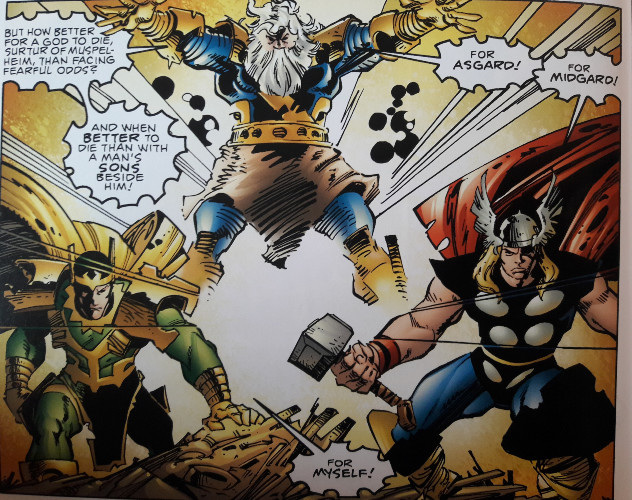
Simonson contributes his dramatic flair to the bulk of the stories presented, with Buscema on art duties for the Balder the Brave limited series and a few Thor issues near the omnibus’ end. As I already alluded, I preferred Simonson’s work to Buscema’s. Simonson’s art provides a wonderfully grandiose vision of the various epics he presents. His characters are bold (perhaps further emboldened by the new coloring), his backgrounds majestic. A running plot sees Surter, lord of Muspelheim, forge a massive sword, Simonson’s art gleefully depicting each strike of the hammer, further embellished by the writer’s penchant for massive sound effects (“DOOM! DOOM!” each blow of the hammer rings out, foreshadowing a coming conflict). His Asgard is suitably grand, his Hel morosely grim. Simonson capably blends elements of fantasy with sci-fi action and mundane street scenes; genres combine at will under his direction, an effortless dance of story and art.
Buscema’s art, by comparison, feels simpler, and though I’ve praised the artist in the past, something feels lacking when he takes over Simonson’s role. The backgrounds aren’t as detailed, the characters not quite as grand. They’re not quite cartoony but still lack the substance Simonson delivered. The shift is not as noticeable in the Balder the Brave limited series, as Buscema crafts all four issues. Here, in this largely standalone epic, Buscema weaves worlds together well, untethered to any previous artist. It’s merely a matter of comparison that left me unable (or unwilling) to enjoy his art as much as I did Simsonson’s efforts.
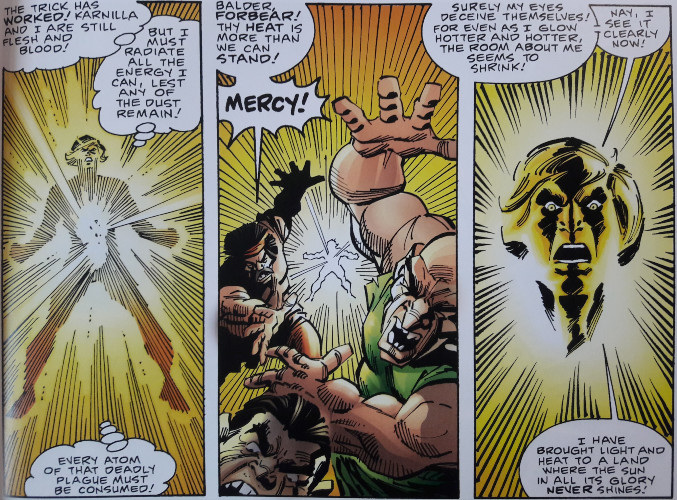
Simonson’s work has been praised for being the run against which all other Thor stories are judged. As someone who hasn’t read much about the thundering deity, I can’t vouch for that particular sentiment. I can proclaim, fortunately, that Simonson provides more than just pretty pictures to examine. That blend I referenced earlier--of fantasy, magic, science fiction, and realism--is achieved practically right off the bat. Simonson quickly introduces the alien Beta Ray Bill, and his star-faring saga intersects tremendously with our hammer-wielding demigod, Thor himself having been recently recruited by Nick Fury. The first issues seamlessly blend ancient Norse mythology with advanced technology--where else can you find a battle royale between Thor and Bill, at the behest of All-Father Odin, shortly before the pair engage in deep space warfare alongside shieldmaiden Sif and Bill’s talking spaceship? Scant issues later, Bill is soaking in the world of New York, allowing Simonson to bring majesty to earth. From the ends of the universe, to the depths of Hel and the alleyways of Manhattan, Simonson's narratives sprawl like Ouroborus, the dragon which eats its tail.
Simsonson continues his saga at a brisk pace, always setting up new stories that have remarkable payoffs. The Surtur story arc takes up a decent chunk of pages, building fantastically until exploding into a massive invasion of New York, pulling together various heroes against the fire demon’s forces. Simonson crafts the action magnificently, his scenes putting even the excellently visual finale to Thor: Ragnarok to shame. From here, Simonson weaves plot after plot, his stories building off one another. A Pyrrhic victory at the end of the Surtur saga leads into an arc where Thor and Co. head to Hel itself in a battle against the death goddess Hela; this, in turn, sews seeds for a grim rivalry between Thor and Hela, as the goddess plots vengeance. Each story organically flows from the one before it, meaning you can easily read this tome cover to cover and never feel jarred by sudden shifts in narrative.
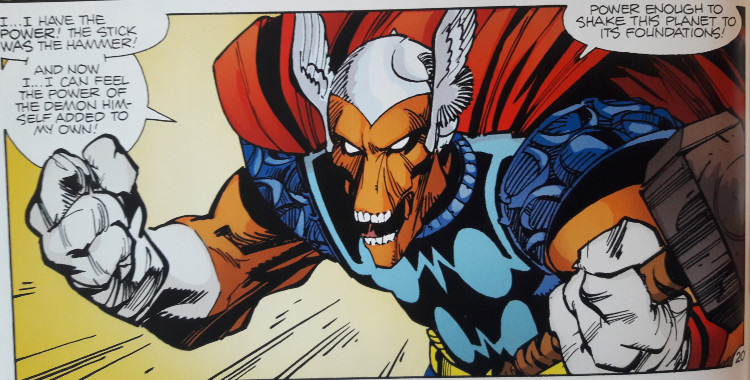
While Simonson wields his powerful pen like Mjolnir itself, shaking up the Nine Realms, he also makes time to add in smaller stories or more entertaining, highly memorable moments. A short arc sees Thor transformed into a frog by Loki’s wicked magic, an engagingly humorous tale that somehow comes across as deeper and somewhat more serious than it should be. Is the concept absolutely ridiculous? I already said “absolutely,” didn’t I? And yet, Simonson makes frog Thor (not to be confused with “Throg,” a similar yet different character) memorable. Even if the story had been shallow or plain, the concept itself would be enough to become ingrained. Other excellent bits include a fight between Thor and the Absorbing Man, set up by the crafty Loki; a gorgeously illustrated issue where a series of splash pages depict a fierce battle between Thor and the Midgard Serpent; and a standalone issue where Thor, grieving over a fallen comrade, encounters a being he believes may be that individual reincarnated. Simonson guides Thor well through his grieving process in a genuinely touching, powerful issue, laying bear the Thunder God’s emotions in a remarkably vulnerable state.
Thor, under the writer, becomes relatable in other ways. A god he may be, but even Thor is not fully immune to injury and heartache. Simonson puts Thor through his paces, dishing out some surprisingly grievous wounds to the Thunder God that mirror his final battle with Hela in Ragnarok. Thor finds his heartstrings tugged, as if they were guided by the Norns themselves, via a couple of different women who can never seem to claim his heart completely. Tension is delivered between not only Thor and these women, but other family members as well. Our stalwart god is, wonderfully, given a very human heart. Simonson, particularly early on, tries to craft Thor a human identity, similar to when the Thunderer was banished to Earth as Donald Blake. This subplot has middling results: it works well when Simonson references it, but the whole “establishing a new identity on Earth” elements only occurs when he deems it necessary; largely sidelined for much more excellent mythic saga, it’s relatability and relevance are left to rust. If anything, this new disguise is notable for how Simonson uses it humorously--jokes range from a construction foreman struggling to determine which superhero the blond behemoth must be (Spider-Man, maybe?) to the disguised demigod bumping into another broad-shouldered fella with glasses named "Clark." Yet, save for these moments, this particular plotline remains largely inconsequential. Surprisingly, Thor is more human when he isn’t in his human guise.
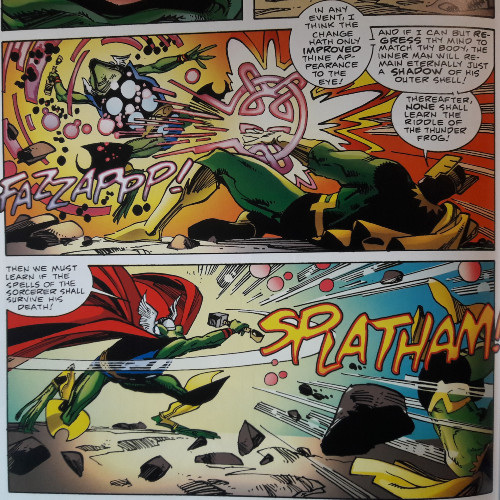
Along with our Thunder God, Simonson wields the bulk of his Asgardian crew impressively. Loki waffles excellently between proud Asgardian and devious demigod; Odin dishes out wisdom and authority as a proud monarch, yet admirably defends his home and people in the face of devastating danger; the Warriors Three, meandering between stories, aid Thor from time to time, proving their worth as long-standing characters; the Enchantress, much like Loki, switches allegiances and genuinely reflects upon her former desire to ensnare Thor; her current beau, Skurge the Executioner, becomes a remarkable character late in the game. Fans of Ragnarok may recall Skurge’s demise after a last-minute change of heart on the Bifrost. Simonson’s Skurge comes off as more of a hero in perhaps the best sequence the writer delivers. Panel upon panel of searing action allow the Executioner one last moment in the sun as he mows down the undead, heroically providing his allies the time needed to escape Hel. It’s possibly one of my favorite moments in comic book history, and I remember being delighted seeing Skurge and his twin machine guns in the first Ragnarok trailer. Again, the movie version didn’t quite live up to expectations, but props to Taiki Waititi for fitting the moment in.
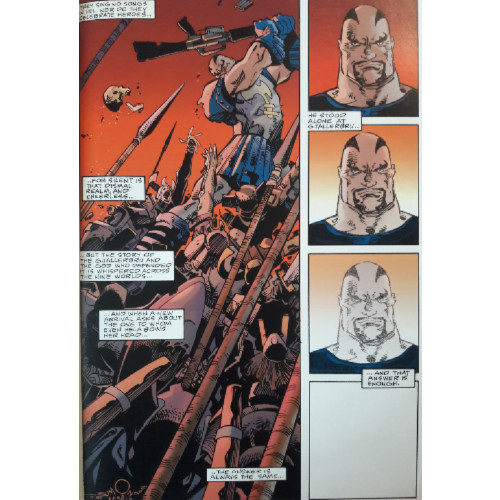
The third Thor movie is, not surprisingly, filled with nods to Simonson’s work beyond the use of Skurge. A moment early in the film where Thor threatens to crush Loki’s skull with an oncoming Mjolnir is taken directly from the comics; Waititi also replicates Thor’s injuries at Hela’s hands and, though done differently than Simonson, brings Surtur to Asgard. In the film, Thor even mentions being turned into a frog at some point in the past, another reference to Simonson’s memorable time on the book. Differences abound between the film and its inspiration--as I already mentioned, Simonson’s final battle with Surtur is played on a much more epic scale--but the little hints showcase Waititi’s understanding and respect for Simonson’s stories.
If any complaint can be lobbed at the writer’s marvelous and mythical meanderings, one may wish to target the end of Simonson’s saga. The comic, for the most part, largely stayed away from major crossovers or even significantly including other Marvel characters while Simonson wrote. There’s a brief mention to the Scourge of the Underworld, a character from Captain America, and X-Factor and Power Pack make cameos in an issue; perhaps most significantly, the Beyonder makes an appearance as part of a Secret Wars II tie-in, but even this fails to distract Simonson from his primary plots. Yet, Simonson’s final issue relies heavily on a Mephisto limited series published at the time, and without that series to provide context, this last issue becomes confusing. The shift from Simonson’s original story to incorporating the events of another series is done awkwardly, and though Simonson plays with the Thor elements very well (he brings back the hulking Destroyer for some fantastic sequences!), he ends up cow-towing to the powers-that-be. Thus, the omnibus ends on a bit of a shallow note, not the impressive finale it could have been if Simonson had been allowed to wrap up dangling plot threads without inserting events from this other series.
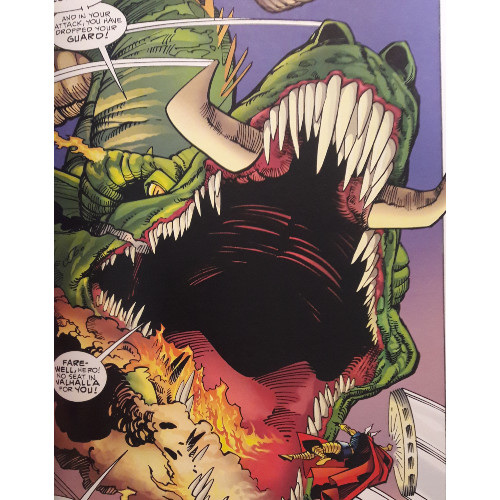
Fortunately, one downer issue out of the 48 presented in this Jotun-sized tome is hardly even a chilly breeze. Simonson’s arcs are epic, his smaller stories touching and entertaining in turns. Thor, Loki, Odin, Balder, the Enchantress, Skurge, the Warriors Three, Surtur, Frost Giants, Hela...so many wonderful pieces of not only Norse mythology but Marvel history become intertwined. A distinctive flow, a perfect cadence, echoes throughout Simonson’s work as he plays and perfects a beautiful balancing act. Even lesser stories are emboldened by references to far-flung mythical epics. You pick up this omnibus, you’ll notice the heft, and that’s certainly due to the page count...but a different kind of density permeates these pages, the kind of weight that only comes from well-told stories of adventure, grandiosity, and noble heroism.